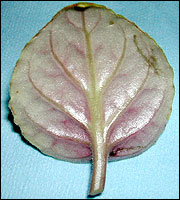
If you enjoy houseplants and want to increase your own collection or if you’d like to share your favorite plants with friends and family there are several easy propagation methods you can use. However, whether you try plant cuttings, plant division, offsets, air layering, or plantlets there are some basic concepts that apply to all propagation methods.
General Propagation Rules
1. Always use clean sharp utensils that have been sterilized in alcohol.
2. Whichever propagation method you select, the parent plant must be healthy. Cuttings taken from a sick or dying plant are doomed to fail.
3. Rooting hormone helps roots develop; but too much is worse than none at all. Since moist conditions are needed for rooting to be successful, it is important to use a rooting hormone that contains a fungicide to prevent plant diseases.
4. The rooting medium should be light and fast draining. If you purchase new construction sand, vermiculite, peat moss, or perlite, it can be used directly from the bag. Medium taken from any other source should be sterilized by heating it in the oven at 200 degrees for 30 minutes.
5. Pots or containers for the new plants must be clean and free of old soil and plant material, if using old pots be sure to wash them well with a household disinfectant. It is important to use exceedingly small containers when you propagate to prevent over watering and help roots development. 2” or 4” pots work well for a single cutting or use a 6” pot for several cuttings.
6. Roots that form in water are different than roots that form in soil. If possible, use soil rather than water to propagate plants.
7. Indirect light and temperatures between 70-80 degrees are best for propagation.
8. Never allow the soil of newly propagated plants to dry out, but on the other hand, the soil should never be soggy. If the planting medium is too dry or too wet, roots don’t develop.
9. To increase the humidity and keep the soil from drying out place newly propagated plants into a plastic bag and seal the top or cover the plants with a sheet of plastic. You can use small picks or sticks to keep the plastic from resting on the plants.
Propagation Techniques
Plant Cuttings
This is when you take a piece of the parent plant and using it to start a new plant. Various parts of the plant can be used for this technique.
Stem Cuttings
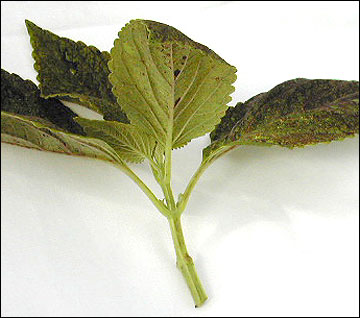
These are the easiest and most common way of propagating houseplants. Use a sharp clean scissors or razor blade to cut a 3”-5” piece from the end of a healthy stem, just below a leaf node. (A node is where a leaf joins the stem.) Remove all the leaves from the bottom 1/3 of the stem and all flowers or buds. Dip the cut end of the stem into a rooting hormone that contains a fungicide. Plant the stem section in a small container of moist soil. Cover the pot with clear plastic or place it in a plastic bag to increase the humidity and prevent the soil from drying out. Check the plant every few days to ensure that the soil is still moist. After a few weeks gently tug on the cutting, if there is resistance the roots have started to grow and the plastic can be removed. This method works well for plants such as: pothos, philodendron, & ivy.
Leaf Cuttings
These are similar to stem cuttings except a leaf is used instead of a stem section. Remove a mature healthy leaf from an actively growing branch, stem, or vine. Dip the cut end of the leaf into a rooting hormone that contains a fungicide. Plant the bottom 1/3 of the leaf in soil. Long leaves, like those of a Snake Plant, can be cut into sections. New plants form around the base of the parent leaf. This method works well for plants such as African Violet, Jade, Sansiviera, and Peperomia.
Cane Cuttings
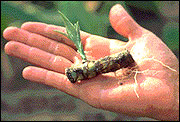
This type of cutting is used when a plant has bare unattractive canes. Cut off a 6”-10” piece of cane and divide it into 3”-4” sections. Each section should have one or two nodes. Dust the cut ends of the canes with a rooting hormone that contains a fungicide. Lay the sections horizontally in soil with the nodes facing upwards and the bottom side of the cane resting in the soil. An alternative Cane Cutting method is to plant several sections vertically in a pot. This method works well for Dracaenas, Ti plants, and Dieffenbachias.
Branch Cuttings
These are ideal for trees with long woody branches. Cut off a 10”-12” healthy branch that has 4-6 nodes on it. The branch should be about ¼” thick. Remove any side branches and all but 2 or 3 of the leaves at the top. Plant the branch and nodes in coarse sterile sand or perlite. This method works with ficus trees and small fruit trees.
Plant Division
This is an easy way to propagate plants that form root clumps or rosettes as they mature. When the plant becomes too crowded in its pot, carefully take it out. Gently pull the root ball into 2 or 3 sections, trying not to damage the roots. Never use a knife to cut the root ball apart. Plant the sections in pots that are a few inches bigger than the new root balls. Try to use approximately the same soil mixture that was in the parent plant. Ferns, Orchids, Shamrock Plants, & Snake Plants can be propagated in this way.
Tuber Division
This is a specialized form of plant division. Certain plants develop thick stems or roots called tubers that store food for the flowers and leaves. These plants, such as caladium, gloxinia, tuberous begonias, and cyclamen should be propagated in the spring as they emerge from dormancy. Take the plant out of its pot and cut the tubers into sections; each section should have a bud. Dip the cut ends of the tubers into a rooting hormone that contains a fungicide. Plant the tuber pieces just below the soil surface in a small pot.
Offsets, Suckers, or Pups are baby plants that form at the base of certain plants. Gently detach the baby plants from the mother plant once they have grown several inches; at this point they should have developed a few roots of their own. Plant the offsets, suckers, or pups in a small pot while their roots continue to develop. Bromeliads, Tulips, Lilies, Aloe Vera can be easily propagated this way.
Air Layering
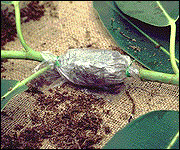
This technique is used primarily for large plants that have thick strong stems and are not easily propagated by other methods. Roots are grown directly on the stem of the parent plant. This is one of the more difficult propagation techniques. Using a sharp clean knife make an upward 1” slit just below a node on the stem. The slit should go about halfway through the stem. Place a piece of toothpick in the slit to keep it open; if the slit heals shut, new roots will not develop. Remove any bark or leaves a few inches above and below the slit. Dust the whole area with a rooting hormone that contains a fungicide. Pack a handful of moist sphagnum moss around the slit, cover the moss with clear plastic, and tie the plastic securely to the stem. Check the moss weekly to be sure it stays moist but not soggy. When roots have filled up the moss, cut the stem below the new root ball and plant it. It may take months before air layering is successful & new roots start to grow, so try to be patient. Weeping Fig, Schefflera, Dieffenbachia and Tree Philodendrons with thick strong stems can be air layered.
Propagation by Plantlets
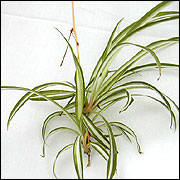
This works for plants that send off long slender stems called runners. At the ends of these stems are new plants, or plantlets, that can be used for propagation. Place these plantlets on top of potting soil while still attached to the mother plant. The plantlets will get nutrition from the parent plant while developing roots of their own. Pin the plantlet to the soil with an open paper clip or a small piece of wire. Once the plantlet has rooted, sever the connection to the parent plant. Alternately, some plantlets can be carefully removed from the stems or leaves of the original plant and directly potted. Spider or airplane plants are the most popular plant that produces plantlets; but so does the Piggyback Plant, Strawberry Plant, and Mother of Thousands Plant.
No matter which method you select, propagation is often a slow process, but your patience will be well rewarded. Judy’s website HousePlant411.com helps plant enthusiasts identify, select, and care for houseplants. It features Ask Judy, which encourages users to send in plant questions, and iCheck Plant, which automatically reminds users by email when and how to correctly water their plants.
Related Articles & Free Email Newsletter
Finding the Correct Propagation Technique for Landscape Plants
Plant Propagation Calendar – What You Should Be Doing Each Month of the Year




Comment here